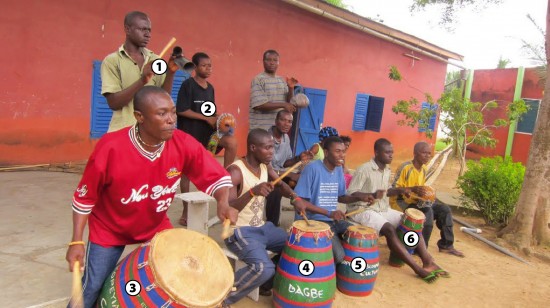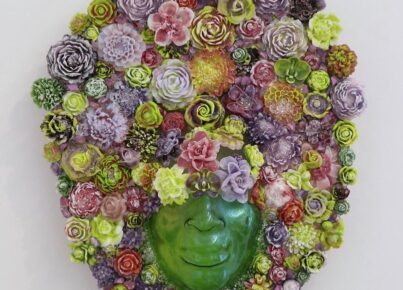According to Ewe Master Drummer Emmanuel Agbeli of Kopeyia, Ghana, Gahu is an adaptation of kokosawa, an older African drum and dance style that originated with the Yoruba people of neighboring Nigeria. The Ewe took kokosawa and increased the tempo to more than double its original value.
Traditional African Instruments
A traditional Gahu drumming ensemble is comprised of six different instrument types, each with a distinct construction, sound, and rhythmic character.

Master drummer Ruben Agbeli (left) of Kopeyia, Ghana, leads a Gahu drumming group on boba.
- Gankogui (pronounced gahn-KOHG-way): Two tone iron bell, one of three “timeline” instruments, its fundamental pattern remains the same throughout the entire form of the piece. Normally there is one gankogui in a Gahu ensemble, sometimes two.
- Axatse (pronounced ah-HAHT-say): African gourd shaker. Also a timeline instrument. There can be between one and five axatse players in an ensemble, sometimes more.
- Boba drum (pronounced boh-BAH): Lead/master drum. By playing specific rhythmic cues, the boba player guides the entire ensemble, including the dancers and singers, through the various sections that comprise the form of Gahu.
- Sogo drum (pronounced SOH-goh): Low-pitched accompaniment drum. One of two “response” drums, its pattern can change in response to rhythmic cues played on the boba. Normally there is one sogo in an ensemble.
- Kidi drum (pronounced KEE-dee): Medium-pitched accompaniment drum. One of two response drums, its pattern can change in response to the boba. Normally there is one kidi in an ensemble.
- Kagan drum (pronounced kah-GAHN): high-pitched accompaniment drum. Third timeline part. Normally there is one kagan in an ensemble.
Form of Gahu
- The overall form of the present-day Agbeli arrangement of Gahu begins with a short introduction of the slower kokosawa (a nod to the past) followed by the up-tempo main section that is, broadly speaking, what we might think of as a rondo:
- ABA—ABCABC—ABDABD—ABEABE—ABFB’ABFB’—ABGB’ABGB’—ABHABH—ABIJ
- The main A section of Gahu, which in choreographic terms is referred to as “free movement” on account of the breezy, economical style that characterizes the dance movements. The B section, commonly known as “serious movement” due to the increased intensity of the dancing, is almost always placed between free movement and one of the variation sections: C, D, E, F, G, H, I, and J, respectively.
Source: http://thisworldmusic.com/gahu-african-drumming-and-dance-from-ghana/





